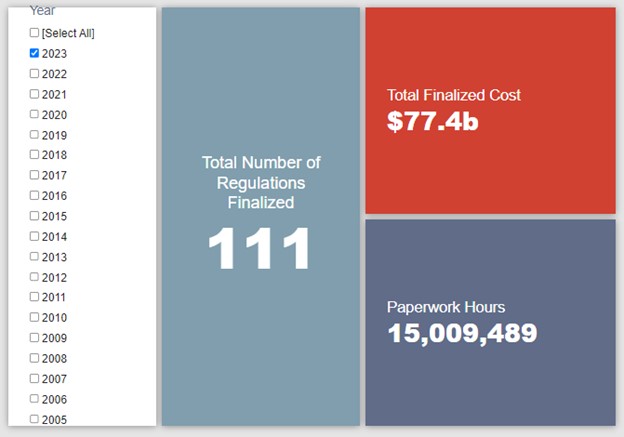Week in Regulation
July 31, 2023
Water Heater Efficiency Rule Keeps Costs in the Billions
This past week saw quite a bit happening in the pages of the Federal Register. There were 16 rulemakings with some quantifiable economic impact, with several having notable effects in terms of costs, savings, and/or paperwork. The main item of the week was a proposed set of efficiency standards from the Department of Energy (DOE) for “consumer water heaters.” Across all rulemakings, agencies published $19.3 billion in total costs and added 4.4 million annual paperwork burden hours.
REGULATORY TOPLINES
- Proposed Rules: 72
- Final Rules: 70
- 2023 Total Pages: 49,179
- 2023 Final Rule Costs: $77.4 billion
- 2023 Proposed Rule Costs: $342.1 billion
NOTABLE REGULATORY ACTIONS
The most significant rulemaking of the week was the DOE proposed rule regarding “Energy Conservation Program: Energy Conservation Standards for Consumer Water Heaters.” The last notable regulatory action on this front came in 2016 and was largely focused on changing the metric standards involved in understanding a given heater’s specifications. One has to go back to 2010 for the last truly substantive update for this product class. As such, it is hardly surprising that these proposed standards represent a dramatic change. DOE estimates that the proposal could result in $19 billion in total “incremental product costs,” making it the costliest set of energy efficiency standards thus far during the Biden Administration.
TRACKING THE ADMINISTRATIONS
As we have already seen from executive orders and memos, the Biden Administration will surely provide plenty of contrasts with the Trump Administration on the regulatory front. And while there is a general expectation that the current administration will seek to broadly restore Obama-esque regulatory actions, there will also be areas where it charts its own course. Since the AAF RegRodeo data extend back to 2005, it is possible to provide weekly updates on how the top-level trends of President Biden’s regulatory record track with those of his two most recent predecessors. The following table provides the cumulative totals of final rules containing some quantified economic impact from each administration through this point in their respective terms.![]() Last week saw a paradoxical shift in the Biden Administration’s final rule totals. While costs dipped by nearly $750 million, paperwork spiked by 4.3 million hours. The main driver of these contrasting trends was a Department of Homeland Security rule introducing an alternative version of the Employment Eligibility Verification form (Form I-9). While the new form brings roughly 1.5 million hours of new paperwork, it will also allow filers to forgo the usual in-person verification process. The savings, in terms of forgone travel and administrative expenses, net out to roughly $318 million annually (or $954 million over a three-year period). For the other two administrations, the most significant movement was a 5.9-million-hour increase under the Obama Administration – due primarily to a Federal Trade Commission rule regarding mortgage advertisements.
Last week saw a paradoxical shift in the Biden Administration’s final rule totals. While costs dipped by nearly $750 million, paperwork spiked by 4.3 million hours. The main driver of these contrasting trends was a Department of Homeland Security rule introducing an alternative version of the Employment Eligibility Verification form (Form I-9). While the new form brings roughly 1.5 million hours of new paperwork, it will also allow filers to forgo the usual in-person verification process. The savings, in terms of forgone travel and administrative expenses, net out to roughly $318 million annually (or $954 million over a three-year period). For the other two administrations, the most significant movement was a 5.9-million-hour increase under the Obama Administration – due primarily to a Federal Trade Commission rule regarding mortgage advertisements.
THIS WEEK’S REGULATORY PICTURE
This week, the regulatory standards for all-terrain vehicles (ATVs) receive a quick update. Source: Photo by Joe Neric on Unsplash
Source: Photo by Joe Neric on Unsplash
Last Thursday, the Consumer Product Safety Commission (CPSC) released a proposed rule with the simple title of “Standard for All-Terrain Vehicles.” The proposal stems from a requirement under the Consumer Product Safety Improvement Act of 2008 (CPSIA) that directs CPSC to essentially codify the protocols and specifications set by private safety standards organizations under a practice called “incorporation by reference” (IBR). In this case, the Commission seeks to update the regulatory code to recognize the latest iteration of the “American National Standard for Four-Wheel All-Terrain Vehicles Equipment Configuration, and Performance Requirements.”
The new set of standards, deemed “ANSI/SVIA 1–2023” since they emanate from the American National Standards Institute (ANSI) and Specialty Vehicle Institute of America (SVIA), focus on the following aspects of ATVs: “Hot Surfaces Requirements,” “Fuel System Requirements,” “Tire Pressure,” and “Owner’s Manual.” For its part, CPSC expects minimal administrative burdens for affected entities with only 441 additional hours of paperwork and $16,000 in commensurate costs each year. So, other than being a good excuse to include a totally rad picture, why is this rulemaking noteworthy?
The reason to highlight this proposed rule – despite its de minimis impacts – is that it provides a useful example of a recently raised issue concerning the IBR rulemaking practice. Earlier this month, Patrick McLaughlin (Senior Research Fellow at the Mercatus Center) looked at how many of these IBR rulemakings derive from standards that interested readers must pay to fully access and found that it could cost said interested reader upward of $250,000 to access all such standards.
In the case of these updated ATV standards, the purchase price is $360. Per the rulemaking text, however, there is a link to a free version via an online, read-only portal. Thus, it is technically available to the public, but in a somewhat inconvenient format. As McLaughlin notes, while there are potential advantages to IBR rulemaking in terms of agency efficiency, there are also transparency and access concerns to consider.
TOTAL BURDENS
Since January 1, the federal government has published $419.5 billion in total net costs (with $77.4 billion in new costs from finalized rules) and 156.9 million hours of net annual paperwork burden increases (with 15 million hours in increases from final rules).










